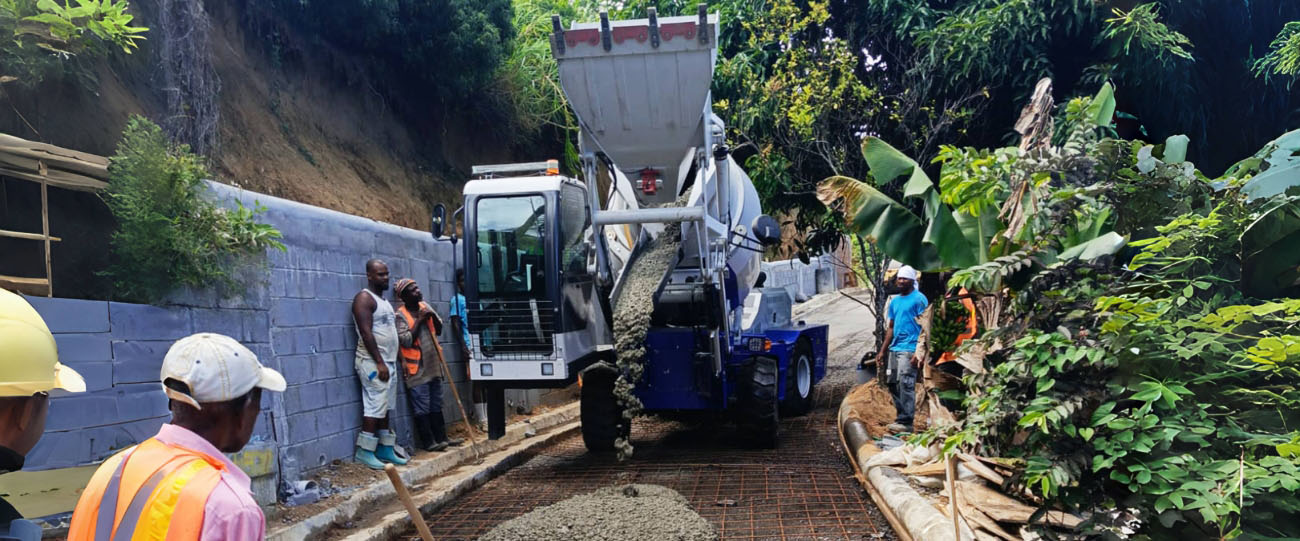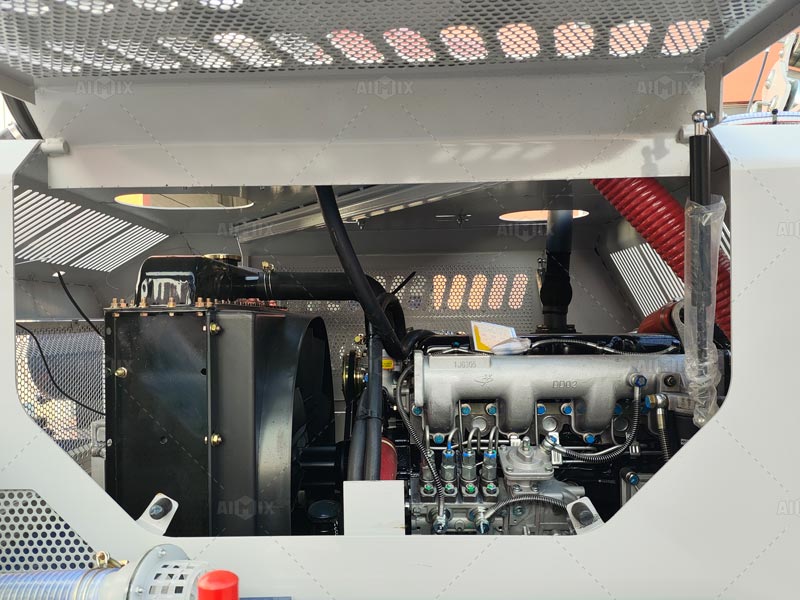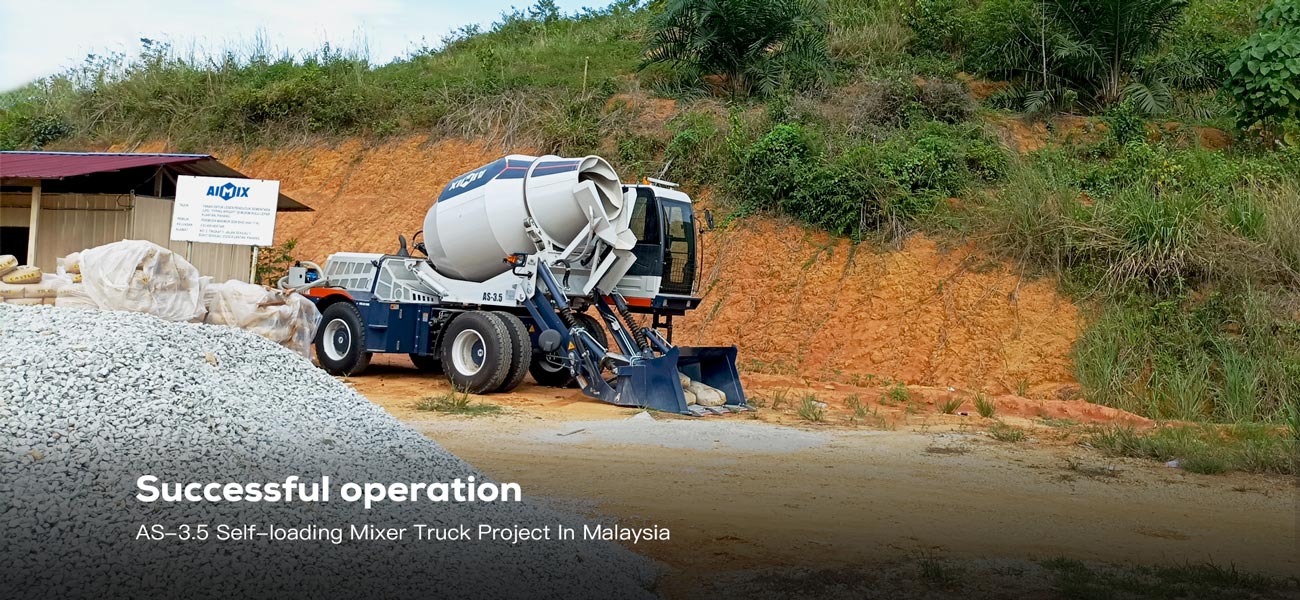In the busy construction line, self-loading concrete mixer has been an indispensable and efficient production tool. It integrates loading, mixing and transporting, which greatly improves the efficiency of the project. However, just like any complex machinery and equipment, it may have various failure problems in long-term high-intensity operation. Reduced loading efficiency, abnormal hydraulic heat, abnormal noise, reduced braking performance or electrical system failure …… If these problems are not solved in time, it may delay the work schedule, or cause huge maintenance costs and economic losses, or even endanger the safety of the operation.

AIMIX not only provides high-quality equipment, but also provides technical support, so that the equipment continues to create value for you. For this reason, our senior engineers have specially compiled this detailed “Common Problems Guide”, which provides you with clear troubleshooting steps and solutions to help you quickly resume production and ensure construction efficiency.
Common Faults in Loading Systems
The loading system is the starting point of the mixer operation, problems here will directly slow down the entire production rhythm.

1.slow loading speed, or even can not load
Phenomenon description: the equipment loading time is obviously longer, the engine roars but the hopper lifting is slow.
Analysis of the underlying causes:
- Lack of hydraulic power: this is the most common reason. Hydraulic oil oil quantity is insufficient, oil aging pollution (such as water, too many impurities) will lead to the hydraulic pump can not establish sufficient pressure. Hydraulic pump or motor itself internal wear and tear, increased leakage, will also cause power loss.
- Excessive mechanical resistance: poor lubrication of the hopper guide, deformation or foreign objects stuck; wire rope or chain wear and tear elongation, jumping teeth; roller bearing damage, will increase the lifting resistance.
- Operation and environmental factors: the tracked chassis is not stopped, the track slips; try to load overloaded materials, beyond the design capacity.
Professional Solution:
- Firstly, check the hydraulic oil: stop the machine to check the oil level and quality of the hydraulic oil.
- Check the mechanical part: observe whether the hopper guide is flat and smooth, and add grease regularly.
- Test the system pressure: use the hydraulic pressure gauge to test whether the working pressure of the loading system reaches the rated value. If the pressure is insufficient, it is necessary to debug the system pressure or overhaul the hydraulic pump and motor.
- Standardised operation: Ensure that the equipment is parked on a solid and level surface and avoid overloading.
2.loading the process of violent shaking or strange noise
Phenomenon Description: The equipment is accompanied by ear-piercing noise or periodic shaking when loading.
Analysis of the underlying causes:
- Loose or damaged connecting parts: the connecting pins and joint bearings of the hopper and lifting arm are worn out beyond the limit.
- Drive train failure: chain too long, worn drive shaft keyways or broken bearings.
- Structural damage: In rare cases, there are minor cracks in the lifting arm or frame, which deforms and triggers rattles when the force is applied.
Professional solution:
- Immediate shutdown for inspection: safety first! Carefully check all visible connecting pins and bolts for looseness or detachment.
- Listen to the sound to identify the location: under the premise of ensuring safety, slowly operate the loading to try to locate the source of the noise. Focus on checking the tension of the drive chain (the lower deflection in the centre should generally be adjusted between 2% and 3%).
Common Faults in Mixing Systems
The mixing system directly determines the homogeneity of the output concrete, and problems here mean that the quality of the work may be compromised.

1.Mixing drum rotates weakly or stops suddenly
Phenomenon: unstable rotation speed of mixing drum, heavy engine load, or even stop rotation during mixing.
Analysis of deeper causes:
- Power transmission interruption: the engine speed does not reach the required speed for hydraulic work; hydraulic system failure; damaged gears and bearings inside the mixing reducer are stuck.
- Overload mixing: too much material or dry hard concrete with too low slump is added, and the starting resistance is far beyond the design value.
- Mechanical jamming: the mixing blades fall off and wedge the gap between the barrel and the blades.
Professional solution:
- Check operation: make sure the engine throttle is at working speed and check for serious overloading.
- Rule out stagnation: Tap the mixing barrel in reverse and try to see if it can rotate slightly. If it is invalid, it is necessary to manually clean the materials in the cylinder and check whether there is any dislodged blade.
- Professional diagnosis: If the above is correct, then professional diagnosis of the hydraulic system and reducer is needed. Whether the input shaft of the reducer rotates and the output shaft does not rotate is the direct basis for judging the damage of the reducer.
2.Uneven mixing, segregation of discharged materials
Phenomenon description: separation of coarse and fine aggregates in the concrete mixture, different colours, poor compatibility.
Analysis of deeper causes:
- Wear of core components: serious wear of mixing blades is the primary reason. The worn blades can’t form effective squeezing and axial tumbling on the materials, resulting in insufficient mixing force.
- Process error: unreasonable loading order (e.g. cement agglomeration in advance), insufficient mixing time, inaccurate weighing system leading to wrong water-cement ratio.
- Equipment design defects: the mixing line speed of inferior equipment is too low, the mixing arm layout is unreasonable, and there is inherently a mixing blind spot.
Professional solution:
- Check and replace the blades: Regularly check the wear of the blades, when the wear width exceeds 50% of the original size, they should be replaced or the angle should be adjusted in time. Use Aimix original blades, which are wear-resistant and corrosion-resistant.
- Standardise the operating procedures: strictly follow the loading sequence and mixing times of the operating instructions.
- Calibrate the weighing system: Aimix self-loading concrete mixers can be calibrated by users using our unique “Weighing Calibration Guidance System”, which ensures that water and powder are placed accurately and that the correct mixing ratio is guaranteed at the source.
Common Faults in Hydraulic System
Hydraulic system is the power source of the equipment, its stability is critical.


1.Hydraulic oil temperature abnormally high (more than 80 ℃)
Phenomenon description: hydraulic oil tank hot, dashboard oil temperature alarm, equipment action becomes slow and weak.
Analysis of deeper causes:
- Poor heat dissipation: hydraulic oil radiator surface is blocked by dust, sludge, fan belt slippage or insufficient speed.
- Oil problems: hydraulic oil viscosity level is not right, oil deterioration, oil level is too low or too high.
- System internal leakage: hydraulic pump, motor, valve group internal components wear, high-pressure oil leakage into heat. Safety valve pressure is set too high, long-term overflow heat.
Professional solution:
- Cleaning and inspection: The first task is to thoroughly clean the radiator fins and check whether the fan is running normally.
- Check oil level: Make sure to use hydraulic oil of specified type and viscosity, and keep the oil level in the standard range.
- Professional overhaul: If the above steps are ineffective, contact a service engineer to test the system pressure, troubleshoot internal leakage points, and adjust the safety valve setting.
2.Hydraulic system oil leakage
Description of the phenomenon: joints, oil seals, piping at the obvious oil stains or dripping.
Deeper cause analysis:
- O-ring and other seals aging; joints loose; high-pressure hose wear rupture.
Professional solutions:
- Regular inspection: Include the hydraulic system inspection in the daily maintenance project, timely detection and tightening of loose joints.
- Replacement of seals and piping: damaged tubing and seals must be replaced immediately.AIMIX provides high-quality fittings to ensure the reliability and longevity of seals.
Common Faults in Braking System
The brake system is directly related to the equipment movement and parking safety, especially in the ramp operation, its reliability can not be lost.

1.Brake failure or braking distance becomes obviously longer
Phenomenon Description: The brake pedal feels weak and soft, the vehicle sliding distance becomes longer, and it is difficult to park on the slope.
Deeper cause analysis:
- Brake fluid problem: insufficient brake fluid, deterioration or air in the pipeline, resulting in the pressure can not be effectively transmitted.
- Brake wear: Excessive wear of brake pads, oil or grooves on the surface of brake discs.
- System leaks: Leaks in the brake sub-pump or lines, resulting in loss of pressure.
Professional solution:
- Check the brake fluid: first check the fluid level in the reservoir, if it is too low, add it to the specified scale and check for leaks. If the fluid is black or has been used for more than 2 years, it is recommended to replace all of it.
- Venting operation: If the pedal is soft, it is likely that there is air in the pipeline, which needs to be vented according to the specifications.
- Inspection of worn parts: check the remaining thickness of the brake pads and clean the oil on the surface of the brake discs.
2.Brake deviation or noise
Phenomenon Description: The vehicle direction deviates when braking, or makes a sharp, dull metal friction sound.
Deeper cause analysis:
- Deviation: there is oil on the one-sided brake, the split pump is stuck or the brake pads are unevenly worn.
- Squeak: the brake pads wear out the alarm pads to give a warning, there are hard foreign objects between the pads and discs, or brake pad material problems.
Professional solution:
- Targeted inspection: for runaway, focus on checking whether both sides of the brake status is symmetrical. For the noise, remove the foreign matter, check the alarm pads, if the pads are thin to the limit, replace them immediately.
Common Faults in Electrical System
The starting and operation of the self loading concrete mixer is highly dependent on the electrical control system, and electrical failures may result in the equipment being paralysed or functioning abnormally.



1.Vehicle cannot be started or starts weakly
Phenomenon description: Turning the key starter does not turn, or the starter speed is slow and can not land the vehicle.
Deeper cause analysis:
- Power supply problems: battery power loss, corrosion and loosening of the pile head, false connection of the hitch wire.
- Starting circuit problems: starter electromagnetic switch damage, starter itself carbon brush wear or short circuit, ignition switch failure.
Professional solution:
- Basic check: first check the battery voltage (static should be higher than 12.5V), clean and tighten the battery pile head and hitch wire.
- Fault judgement: short the two big terminals on the starter electromagnetic switch, if the starter rotates strongly, the problem is in the electromagnetic switch or upstream circuit; if it still doesn’t rotate or is powerless, the problem is in the starter itself or the battery charge is insufficient.
2.Lights, instruments or sensors work abnormally
Phenomenon Description: Some of the lights do not light up, the instrument display is inaccurate or flickering, and the sensor signal is sporadic.
Deeper cause analysis:
- Wiring problems: blown fuse, relay failure, wiring harness plug into the water oxidation or loosening, line broken skin hitch.
- Component damage: bulbs, sensors, the instrument itself is damaged.
Professional solution:
- Check the corresponding fuses and relays first, then check whether the plugs of related components are connected reliably and corrosion-free.
- Component Replacement: For suspected damaged sensors, etc., the replacement method can be used for testing.
Professional Services Aimix Provided
AIMIX self loading concrete mixers have passed ISO 9001, CE certification and other quality tests, with a low failure rate and more than 1,000 customers’ feedback saying that they are trouble-free within two years. Even if you encounter complex faults that cannot be solved by yourself, the global service network will be your most solid backing. We provide:


7×24 hours remote technical support
rapid troubleshooting via phone or video guidance.
![]()
Rapid on-site response
professional engineers with original spare parts, quickly arrive at the scene.
![]()
Perfect spare parts supply
Ensure that you can always get pure, high-quality replacement parts.
Of course, if you want to minimise breakdowns at the source, choose an equipment supplier that focuses on product quality, like AIMIX. We have a worldwide professional service team and an extensive spare parts inventory to provide quick response and remote technical guidance to ensure worry-free operation of our customers’ equipment. Last but not least, if you can’t find the answer to your question here, or need professional technical support, please feel free to contact us.




